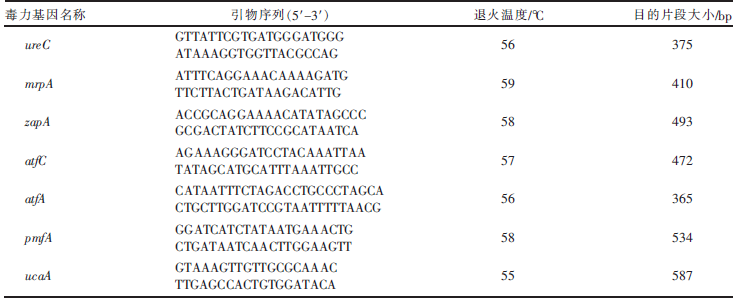| [1] |
刘泽文, 袁芳艳, 田永祥, 等. 猪变形杆菌病的研究进展[J]. 安徽农业科学, 2014, 42(12):3578-3579.
|
| [2] |
CHEN C Y, CHEN Y H, LU P L, et al. Proteus mirabilis urinary tract infection and bacteremia: Risk factors, clinical presentation, and outcomes[J]. Journal of Microbiology, Immunology and Infection, 2012, 45(3):228-236.
doi: 10.1016/j.jmii.2011.11.007
|
| [3] |
董萌萌, 徐彦召, 杭柏林, 等. 猪源奇异变形杆菌的分离鉴定与耐药性分析[J]. 中国兽医杂志, 2018, 54(5):82-85,136.
|
| [4] |
CHINNAM B K, NELAPATI S, TUMATI S R, et al. Detection of β-lactamase-producing Proteus mirabilis strains of animal origin in Andhra Pradesh, India and their genetic diversity[J]. Journal of Food Protection, 2021, 84(8):1374-1379.
doi: 10.4315/JFP-20-399
|
| [5] |
QU X Y, ZHOU J, HUANG H Q, et al. Genomic investigation of Proteus mirabilis isolates recovered from pig farms in Zhejiang Province, China[J]. Frontiers in Microbiology, 2022, 13:952982.
doi: 10.3389/fmicb.2022.952982
|
| [6] |
刘妍罕, 曾茂芹, 张飘, 等. 野猪源奇异变形杆菌的分离鉴定及致病性分析[J]. 中国动物传染病学报, 2022, 30(1):44-52.
|
| [7] |
葛强, 马东鑫, 周雨晴, 等. 猪源奇异变形杆菌的分离鉴定及特征分析[J]. 中国畜牧兽医, 2021, 48(5): 1804-1815.
|
| [8] |
姚火春. 兽医微生物学实验指导[M]. 北京: 中国农业出版社, 2002.
|
| [9] |
苏治国, 陈文芳. 泰州地区致仔猪腹泻奇异变形杆菌鉴定及其毒力基因与耐药性检测[J]. 畜牧与兽医, 2019, 51(11):118-122.
|
| [10] |
ARENDRUP M C, PRAKASH A, MELETIADIS J, et al. Comparison of EUCAST and CLSI reference microdilution MICs of eight antifungal compounds for Candida auris and associated tentative epidemiological cutoff values[J]. Antimicrobial Agents and Chemotherapy, 2017, 61(6):e00485-17.
|
| [11] |
张利锋, 李娟, 卢金星. 奇异变形杆菌耐药性研究进展[J]. 疾病监测, 2016, 31(5):427-432.
|
| [12] |
黎娜铭, 王彬, 舒正强, 等. 猪源奇异变形杆菌的分离鉴定、耐药性分析及毒力基因检测[J]. 畜牧与兽医, 2021, 53(3):89-94.
|
| [13] |
邓红玉, 庄育彬, 蔡一龙, 等. 猪奇异变形杆菌的分离鉴定及分子生物学分析[J]. 中国兽医杂志, 2015, 51(3):20-23.
|
| [14] |
马婷婷, 韦显凯, 闭璟珊, 等. 猪源奇异变形杆菌的分离鉴定及其毒力的测定[J]. 中国兽医科学, 2017, 47(10):1234-1239.
|
| [15] |
尹有勤, 韩春华, 崔一龙, 等. 不同来源奇异变形杆菌对小鼠致病力及其毒力基因携带情况的比较[J]. 中国生物制品学杂志, 2019, 32(3):289-294.
|
| [16] |
SUN Y, WEN S, ZHAO L, et al. Association among biofilm formation, virulence gene expression, and antibiotic resistance in Proteus mirabilis isolates from diarrhetic animals in northeast China[J]. BioMed Central Veterinary Research, 2020, 16(1):176.
|










